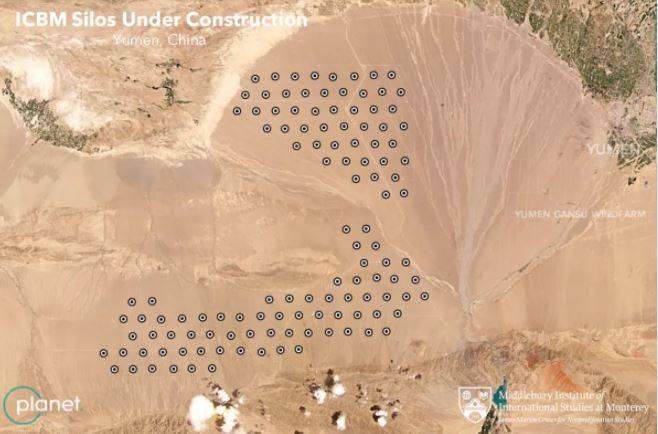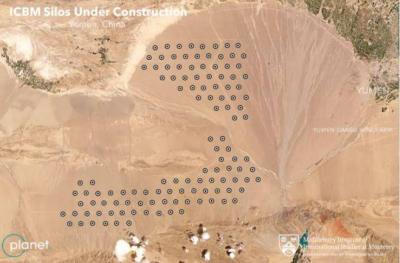The Washington Post reported on Wednesday that China has begun constructing over 100 new launch platforms for intercontinental ballistic missiles in a desert near the city of Yumen, in the northwest of the country, in a building wave that may indicate a "significant expansion of Beijing's nuclear capabilities." The newspaper added that commercial satellite images obtained by researchers at the James Martin Center for Nonproliferation Studies in Monterey, California, show ongoing work at dozens of sites across a network covering hundreds of square miles of arid terrain in Gansu Province.
The 119 nearly identical construction sites have features that match those seen at existing launch facilities for China’s nuclear warhead-armed ballistic missile stockpile. The Washington Post suggested that acquiring over 100 new missile launch platforms, if completed, would represent a historic shift for China, a country believed to hold a relatively modest stock of 250 to 350 nuclear weapons.
According to the newspaper, the actual number of new missiles designated for these platforms is unknown and may be much smaller, as China has previously deployed missile launch platforms for camouflage. However, "the construction boom indicates a major effort to enhance the credibility of China's nuclear deterrence," according to researcher Jeffrey Lewis, an expert on China's nuclear arsenal and part of the team that analyzed the suspicious sites, which were first discovered by his colleague Decker Eveleth while examining images captured by commercial satellites over northwest China.
Lewis, who is the director of the East Asia Nuclear Weapons Nonproliferation Program at the Center for Nonproliferation Studies, described the scale of the construction wave as "stunning" in a summary of his findings presented to the Washington Post. He added, "If the launch platforms being constructed at other sites across China are included, the total number under construction is about 145." He continued, "We believe that China is expanding its nuclear forces partly to maintain a deterrent that can withstand a U.S. first strike with enough numbers to defeat U.S. missile defenses."
Lewis speculated that the launch platforms are intended for the Chinese intercontinental ballistic missile known as "DF-41," which can carry multiple warheads and reach targets up to 9,300 miles away, placing the mainland United States within range. He noted that major excavation work at the sites began earlier this year, although preparations had likely been ongoing for months.
The Washington Post pointed out that missile launch platforms can easily be detected by trained image analysts and are vulnerable to destruction by precision-guided missiles in the early hours of a nuclear war. For these reasons, Lewis believes that the missile launch platform construction project is part of an "expanded deterrence strategy" by a country whose nuclear arsenal pales in comparison to the arsenals of the United States and Russia, which together possess over 11,000 nuclear warheads.
Rather than engaging in an expensive arms race with Washington and Moscow, China has traditionally embraced a "limited deterrence" doctrine that prioritizes a small yet powerful nuclear arsenal to ensure Beijing's ability to retaliate against any adversary if attacked. However, in recent years, Chinese officials have stated that their country’s nuclear deterrent is losing credibility due to ongoing or proposed nuclear modernization programs in Russia and the United States.
Beijing has resisted calls to join new arms limitation talks due to concerns that new restrictions would enshrine its status as a second-tier nuclear power compared to Washington and Moscow.
### U.S. Warnings
This discovery comes after recent warnings from U.S. Department of Defense officials regarding the rapid advancement of China's nuclear capabilities. Admiral Charles Richard, who heads the U.S. Strategic Command responsible for nuclear deterrence, stated that a "huge expansion" is occurring in China, including an expanded arsenal of intercontinental ballistic missiles and mobile missile launch platforms that can be easily concealed from satellites.
During a congressional hearing last April, he added that the Chinese navy has introduced new submarines with nuclear capabilities into its growing fleet. The Washington Post reported that it did not receive a response to emails seeking comments from the Chinese Foreign Ministry in Beijing or the Chinese Embassy in Washington. A Pentagon spokesman also declined to comment on the satellite images or discuss U.S. intelligence assessments of China’s nuclear program. However, Pentagon spokesman John Kirby noted that previous Pentagon reports and analysts have expressed concern about the spread of Chinese missile launch platforms, with Kirby stating, "Defense Department leaders have testified and spoken publicly about China's growing nuclear capabilities, which we expect to double or more over the next decade."
In February, Secretary of State Antony Blinken pledged in a statement that the Biden administration "will continue to pursue arms control to reduce the risks from China's modernizing and growing nuclear arsenal." While he did not clarify how this goal would be achieved, he stated that the administration would seek to "implement effective arms control measures that enhance stability, transparency, and predictability while reducing the risks of dangerous and costly arms races."
### Chinese President: The Era of Bullying is Over
In a speech marking the centenary of the founding of the ruling Communist Party, Chinese President Xi Jinping stated that “the era of oppression and bullying by Beijing is over for good," according to Agence France-Presse.
While addressing a large crowd in Tiananmen Square in the heart of Beijing, he said, "The Chinese people have risen. The time when the Chinese people were trampled upon, suffered, and oppressed has gone forever," describing the renaissance that his country is experiencing as a "historic journey."




